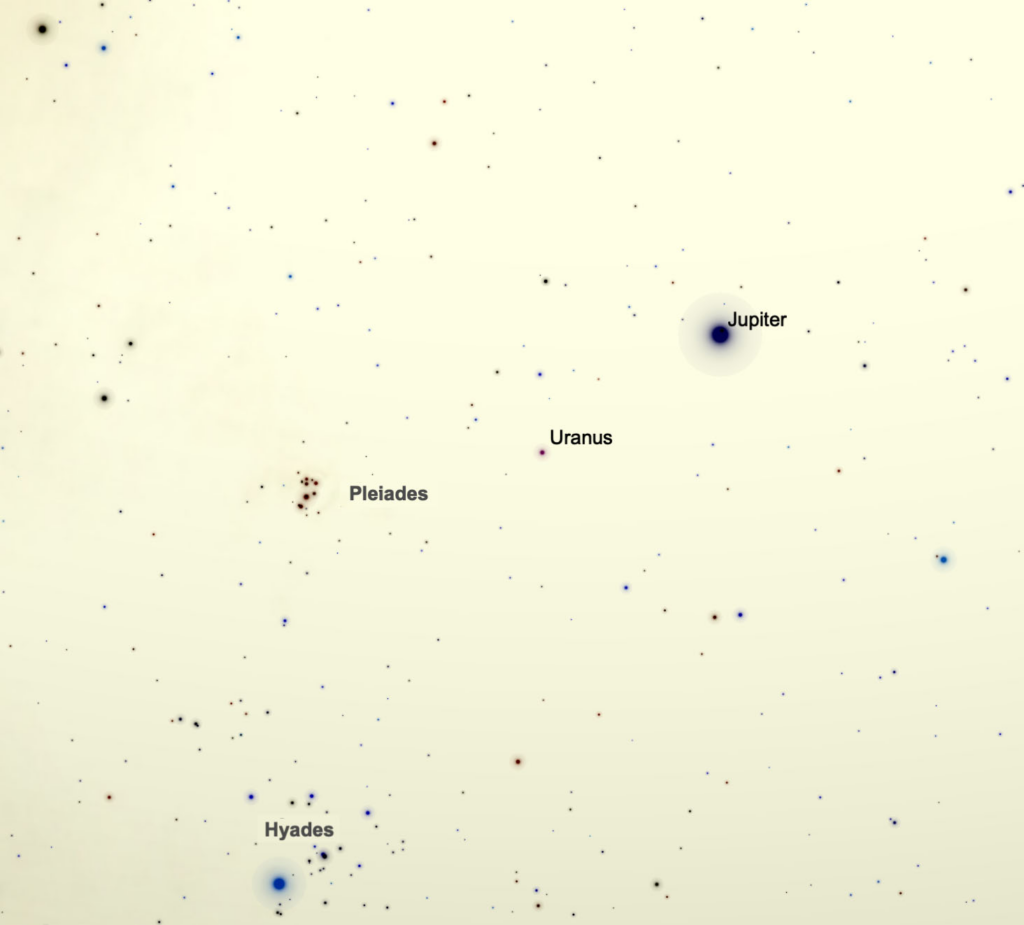Sky Report: September 11 – 17

This is a negative map of the sky around Uranus; it’s easier to see stars and planets as black dots on a white background. The faintest stars shown are ½ as bright as Uranus. These planets move slowly so the map is useful all month, and the view spans 35°. Graphic created with SkySafariAstronomy.com.
Comet Nishimura, discovered only one month ago, passes closest to the earth on the 12th when it is 73 million miles distant. It’ll be near its brightest then and could be a naked-eye treat except that it rises essentially at the same time that the sun rises — and can’t be seen.
Days later, on the 17th, the comet passes closest to the sun, 27 million miles from it. This is considerably closer to the sun than the planet Mercury and the comet will be subjected to immense heat and tidal stresses. No one will be surprised if it doesn’t survive.
After the 17th the comet remains far too close to the sun as viewed from earth as it recedes back to the outer solar system. Comet Nishimura – or whatever survives – returns in the year 2543. Google “Comet Nishimura” and especially go to https://earthsky.org/ for more information.
Turning to things you can see, three planets are easily visible tonight, weather permitting. These are Saturn and Jupiter in the evening sky and Venus in the morning.
Saturn rises at sunset, and it’s low in the southeast when the sky has become fully dark. It’s by far the brightest object in Aquarius, which isn’t saying much because Aquarius lies some distance from the Milky Way and has no bright stars of its own. The one moderately bright star below Saturn is Fomalhaut in Piscis Austrinus, the Southern Fishes, a small and obscure constellation that barely rises from our latitude.
Jupiter follows 3 hours behind Saturn, and it’s the brightest thing in the sky, other than the moon, until Venus rises. Jupiter is in Aries, another constellation without bright stars, so you can’t miss it.
You will miss Uranus, unless you have binoculars or a telescope. People with excellent eyesight under the darkest sky have seen Uranus with the naked eye, but don’t count on doing it yourself. Uranus is 7½° to the east of Jupiter (midway between Jupiter and the Pleiades), and that is as close as the two planets will come this year (Jupiter will be in retrograde motion, moving westward and away from Uranus). Uranus is 4½ times as distant as Jupiter and it’s a bit more than a third Jupiter’s diameter, so you would expect it to be fainter; Jupiter is 2300 times brighter. A large telescope will show that Uranus is slightly blue-green in color, and this is due to methane in its atmosphere which absorbs the red portion of sunlight that strikes it. This is a wonderful opportunity to find Uranus by yourself. Binoculars will reveal it easily; just use the accompanying map.
The last planet to rise is Venus, now rising 3 hours before the sun and well-up while you eat an early breakfast.
A heads-up: there will be a MAJOR — but not total — eclipse of the sun visible from the entire country, but especially Utah, Nevada, Arizona, New Mexico, and Texas, next month on the 14th. I’ll write about it next week, but in the meantime Google “eclipse October 2023” for info.
Stellar Vista Observatory provides portable telescopes and tripod mounted binocular kits on loan for free to residents and visitors in Kane County. Enhance your enjoyment of the night sky! To learn more, request a loan, or attend one of SVO’s free public star parties for 2023, visit https://stellarvistaobservatory.org/ or drop in to the Kane County Office of Tourism.






Comments are closed.